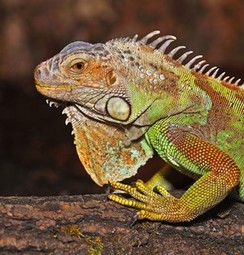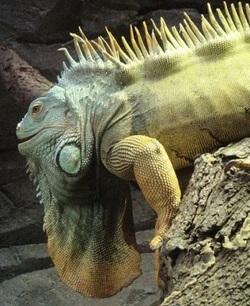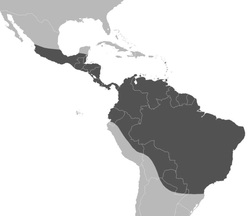Green IguanaIguana iguana |

Custom Search
|
|
The green iguana (Iguana iguana) can be found in Central America and northern South America. The green iguana lives in tropical rain forests, mangroves and in relatively arid areas but with plenty of resources, and always near water.
Being a popular exotic pet they were introduced unintentionally (or not) by humans in Florida, and are thriving like other invasive species such as the Nile monitor lizard or the burmese python and reticulated python. The green iguana may reach 1.5 to 2 meters in length (including the tail, which can measure nearly 3 times the length of the body itself). Their skin color despite the name varies from predominantly green to orange or even black, marked with transverse bands on the side (especially in the "shoulders" and tail) which will darken with age, the juveniles are green and may have blueish markings,that will fade as they grow. The dominant males show orange color in the front legs and , a lighter color on the snout. The green iguana has a kind of serrated teeth and a crest in the mid-dorsal line, extending from the neck to the tail, with longer scales on the neck region.
Males are longer, have a larger head, their spiny crest is more developed than the one on the females and the barb (fold of skin between the mouth and neck) is also larger. These reptiles are diurnal and gregarious, seeking food and catch sunlight in the trees in groups. However, males are territorial and may cause or suffer significant injuries in their fight for a position of dominance, territory or greater access to females. The green iguanas, have both terrestrial and arboreal habits, preferring locations with dense vegetation in the lower canopy of trees. They climb with great ease with the help of their long fingers and long tail (which can measure three times the length of the body). They are able to defend themselves using the tail, while preferring to seek safety shooting up into the water and swimming with great agility. When grasped by the tail, it can be broken at specific points of fracture, allowing them to escape, in some cases, the tail grows back, depending on the location of fracture and age of the individual. Green Iguana - Diet
Juveniles feed on insects, snails and worms, in addition to vegetable matter. Adults are mainly vegetarian eating fruits, flowers and leaves. Green Iguana - Reproduction This is an oviparous species. The females gather in the territories of larger males and mate preferentially with these. The mating season takes place in autumn (the first half of the dry season). The eggs are laid in the second half of the dry season. There are reports of them sharing nesting sites with 2 crocodilian species, the American Crocodile and the Spectacled Caiman. The female lays from 12 to 40 eggs in a hole she digs in sandy soil. The incubation period lasts 10 to 15 weeks, with births during the late dry season or early wet season. They reach sexual maturity between 16 to 18 months of age with a minimum length of 23 cm (excluding the tail). Green Iguana - Conservation status and major threats The species is not threatened globally (according to the International Union for Conservation of Nature). It belongs to the CITES Appendix II. Adults and eggs are much sought for human consumption or for the illegal trade of pets, which lead to some threatened populations. The Green Iguana is a very popular exotic pet, there are several captive breeding projects that aim to minimize the pressure, that wild populations have been submitted for this reason.
|
Scientific classification
Kingdom: Animalia Phylum: Chordata Class: Reptilia Order: Squamata Family: Iguanidae Genus: Iguana Species: I. iguana |



